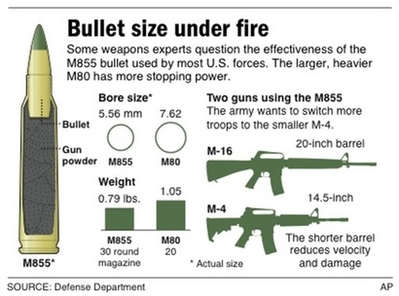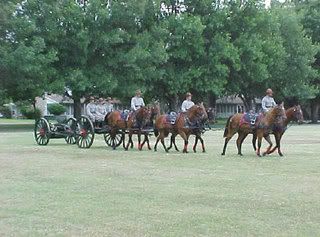(as usual, such NewsItems tend to "go away", so I saved a copy)
NOTE: the last-sentence in the article...
http://News.Yahoo.com/s/ap/20080527/ap_ ... _bullets_3

ADVANCE FOR MAY 27; graphic compares two bullets used by the U.S. military;
2c x 2 3/4 inches; 96.3 mm x 69.9 mm
US uses bullets ill-suited for new ways of war
By RICHARD LARDNER, Associated Press Writer
Monday 26 May 2008 19:15
WASHINGTON - As Sgt. Joe Higgins patrolled the streets of Saba al-Bor, a tough town north of Baghdad, he was armed with bullets that had a lot more firepower than those of his 4th Infantry Division buddies.
As an Army sniper, Higgins was one of the select few toting an M14. The long-barreled rifle, an imposing weapon built for wars long past, spits out bullets larger and more deadly than the rounds that fit into the M4 carbines and M16 rifles that most soldiers carry.
"Having a heavy cartridge in an urban environment like that was definitely a good choice," says Higgins, who did two tours in Iraq and left the service last year. "It just has more stopping power."
Strange as it sounds, nearly seven years into the wars in Afghanistan and Iraq, bullets are a controversial subject for the U.S.
The smaller, steel-penetrating M855 rounds continue to be a weak spot in the American arsenal. They are not lethal enough to bring down an enemy decisively, and that puts troops at risk, according to Associated Press interviews.
Designed decades ago to puncture a Soviet soldier's helmet hundreds of yards away, the M855 rounds are being used for very different targets in Iraq and Afghanistan. Much of today's fighting takes place in close quarters; narrow streets, stairways and rooftops are today's battlefield. Legions of armor-clad Russians marching through the Fulda Gap in Germany have given way to insurgents and terrorists who hit and run.
Fired at short range, the M855 round is prone to pass through a body like a needle through fabric. That does not mean being shot is a pain-free experience. But unless the bullet strikes a vital organ or the spine, the adrenaline-fueled enemy may have the strength to keep on fighting and even live to fight another day.
In 2006, the Army asked a private research organization to survey 2,600 soldiers who had served in Iraq and Afghanistan. Nearly one-fifth of those who used the M4 and M16 rifles wanted larger caliber bullets.
Yet the Army is not changing. The answer is better aim, not bigger bullets, officials say.
"If you hit a guy in the right spot, it doesn't matter what you shoot him with," said Maj. Thomas Henthorn, chief of the small arms division at Fort Benning, Ga., home to the Army's infantry school.
At about 33 cents each, bullets do not get a lot of public attention in Washington, where the size of the debate is usually measured by how much a piece of equipment costs. But billions of M855 rounds have been produced, and Congress is preparing to pay for many more. The defense request for the budget year that begins Oct. 1 seeks $88 million for 267 million M855s, each one about the size of a AAA battery.
None of the M855's shortcomings is surprising, said Don Alexander, a retired Army chief warrant officer with combat tours in Iraq, Afghanistan, Bosnia and Somalia.
"The bullet does exactly what it was designed to do. It just doesn't do very well at close ranges against smaller-statured people that are lightly equipped and clothed," says Alexander, who spent most of his 26-year military career with the 5th Special Forces Group.
Paul Howe was part of a U.S. military task force 15 years ago in Mogadishu, Somalia's slum-choked capital, when he saw a Somali fighter hit in the back from about a dozen feet away with an M855 round.
"I saw it poof out the other side through his shirt," says Howe, a retired master sergeant and a former member of the Army's elite Delta Force. "The guy just spun around and looked at where the round came from. He got shot a couple more times, but the first round didn't faze him."
With the M855, troops have to hit their targets with more rounds, said Howe, who owns a combat shooting school in Texas. That can be tough to do under high-stress conditions when one shot is all a soldier might get.
"The bullet is just not big enough," he says. "If I'm going into a room against somebody that's determined to kill me, I want to put him down as fast as possible."
Dr. Martin Fackler, a former combat surgeon and a leading authority on bullet injuries, said the problem is the gun, not the bullet. The M4 rifle has a 14.5 inch barrel — too short to create the velocity needed for an M855 bullet to do maximum damage to the body.
"The faster a bullet hits the tissue, the more it's going to fragment," says Fackler. "Bullets that go faster cause more damage. It's that simple."
Rules of war limit the type of ammunition conventional military units can shoot. The Hague Convention of 1899 bars hollow point bullets that expand in the body and cause injuries that someone is less likely to survive. The United States was not a party to that agreement. Yet, as most countries do, it adheres to the treaty, according to the International Committee of the Red Cross.
The Hague restrictions do not apply to law enforcement agencies, however. Ballistics expert Gary Roberts said that is an inconsistency that needs to be remedied, particularly at a time when so many other types of destructive ordnance are allowed in combat.
"It is time to update this antiquated idea and allow U.S. military personnel to use the same proven ammunition," Roberts says.
In response to complaints from troops about the M855, the Army's Picatinny Arsenal in New Jersey assigned a team of soldiers, scientists, doctors and engineers to examine the round's effectiveness. The team's findings, announced in May 2006, concluded there were no commercially available rounds of similar size better than the M855.
But Anthony Milavic, a retired Marine Corps major, said the Army buried the study's most important conclusion: that larger-caliber bullets are more potent.
"It was manipulated," says Milavic, a Vietnam veteran who manages an online military affairs forum called MILINET. "Everybody knows there are bullets out there that are better."
Officials at Picatinny Arsenal declined to be interviewed. In an e-mailed response to questions, they called the M855 "an overall good performer." Studies are being conducted to see if it can be made more lethal without violating the Hague Convention, they said.
Larger rounds are not necessarily better, they also said. Other factors such as the weather, the amount of light and the bullet's angle of entry also figure into how lethal a single shot may be.
Heavier rounds also mean more weight for soldiers to carry, as well as more recoil — the backward kick created when a round is fired. That long has been a serious issue for the military, which has troops of varied size and strength.
The M14 rifle used by Joe Higgins was once destined to be the weapon of choice for all U.S. military personnel. When switched to the automatic fire mode, the M14 could shoot several hundred rounds a minute. But most soldiers could not control the gun, and in the mid-1960s it gave way to the M16 and its smaller cartridge. The few remaining M14s are used by snipers and marksman.
U.S. Special Operations Command in Tampa, Fla., is buying a carbine called the SCAR Heavy for its commandos, and it shoots the same round as the M14. The regular Army, though, has invested heavily in M4 and M16 rifles and has no plans to get rid of them.
A change in expectations is needed more than a change in gear, said Col. Robert Radcliffe, chief of combat developments at Fort Benning. Soldiers go through training believing that simply hitting a part of their target is enough to kill it. On a training range, getting close to the bulls-eye counts. But in actual combat, nicking the edges isn't enough.
"Where you hit is essential to the equation," Radcliffe says. "I think the expectations are a little bit off in terms of combat performance against target range performance. And part of that is our fault for allowing that expectation to grow when it's really not there at all."
The arguments over larger calibers, Radcliffe says, are normal in military circles where emotions over guns and bullets can run high.
"One of the things I've discovered in guns is that damned near everyone is an expert," he says. "And they all have opinions."
___
On the Net: Army's Picatinny Arsenal: http://tinyurl.com/6vlwm







 [/quote
[/quote
